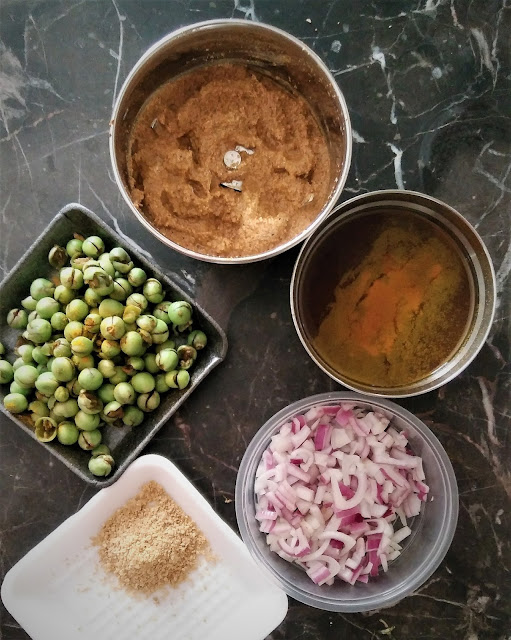When we intended to have a garden in our home in Coimbatore, we arranged with a landscape outfit to help us. Once we had put some plants and a small vegetable patch, we were enjoying some home grown beans, greens and few other vegetables. Soon we moved to a project in Qatar and hence hired a gardener to take care of the garden. Just before leaving home, while emptying stuff I dropped some chilli seeds from the pack of dry red chillis I had, in a small patch. Those have grown and were yielding when I visited last month. I plucked out about half of a kilo of green chillis.
After sharing some, I wanted to bring them and use here.
I shared some pictures on Instagram and took suggestions from friends on many ways to use them. Pickles seem to be a favourite. I made the milagai gojju and some pachchai milagai chutney.
While I spoke to my mother, she gave me this simple recipe for a chutney that did not need a curing period more than a couple of days. She suggested that if I had some limes in brine, they can be used for immediate use. Otherwise, it takes about three days when the lime pieces absorb the flavours and the chutney can be used.
This is a very simple recipe that can be combined in few minutes.
Pachchai Milagai Elumichchai Chutney
Makes about 150 ml
Ingredients:
30-35 fresh green chillis
6 small size limes
1/3 tablespoon salt (to be adjusted according to heat of the chillis)
1 teaspoon sugar
Method:
Wash the chillis and dry them on a towel. Remove their stalks.
Cut the limes and partly squeeze their juice into a bowl. Add the sugar and keep aside.
Cut the limes in small bits and mix the salt.
Blend the chillis in a blender to a smooth paste using the lime juice.
Transfer to the bowl and add the lime pieces to this.
Mix well and store in a clean glass or ceramic jar.
Keep the chutney at room temperature for a few days, giving it a stir twice or thrice a day.
In a couple of days, the lime bits will soften and lose any bitter taste.
The chutney is ready to serve.
This stays well at room temperature for about a week, in refrigeration for a month.
This can be served as pickle with rice or as chutneys with idli, dosai and such.
Notes:
If you have available some lime/lemon that has been cured in salt, you may substitute them for the lime bits. Thus, the chutney can be enjoyed immediately.
The heat and humidity in my country is high this summer that the chutney was fermenting by the fourth day even as the limes were still crunchy. I had to refrigerate the chutney then.
After sharing some, I wanted to bring them and use here.
I shared some pictures on Instagram and took suggestions from friends on many ways to use them. Pickles seem to be a favourite. I made the milagai gojju and some pachchai milagai chutney.
While I spoke to my mother, she gave me this simple recipe for a chutney that did not need a curing period more than a couple of days. She suggested that if I had some limes in brine, they can be used for immediate use. Otherwise, it takes about three days when the lime pieces absorb the flavours and the chutney can be used.
This is a very simple recipe that can be combined in few minutes.
Pachchai Milagai Elumichchai Chutney
Makes about 150 ml
Ingredients:
30-35 fresh green chillis
6 small size limes
1/3 tablespoon salt (to be adjusted according to heat of the chillis)
1 teaspoon sugar
Method:
Wash the chillis and dry them on a towel. Remove their stalks.
Cut the limes and partly squeeze their juice into a bowl. Add the sugar and keep aside.
Cut the limes in small bits and mix the salt.
Blend the chillis in a blender to a smooth paste using the lime juice.
Transfer to the bowl and add the lime pieces to this.
Mix well and store in a clean glass or ceramic jar.
Keep the chutney at room temperature for a few days, giving it a stir twice or thrice a day.
In a couple of days, the lime bits will soften and lose any bitter taste.
The chutney is ready to serve.
This stays well at room temperature for about a week, in refrigeration for a month.
This can be served as pickle with rice or as chutneys with idli, dosai and such.
Notes:
If you have available some lime/lemon that has been cured in salt, you may substitute them for the lime bits. Thus, the chutney can be enjoyed immediately.
The heat and humidity in my country is high this summer that the chutney was fermenting by the fourth day even as the limes were still crunchy. I had to refrigerate the chutney then.










